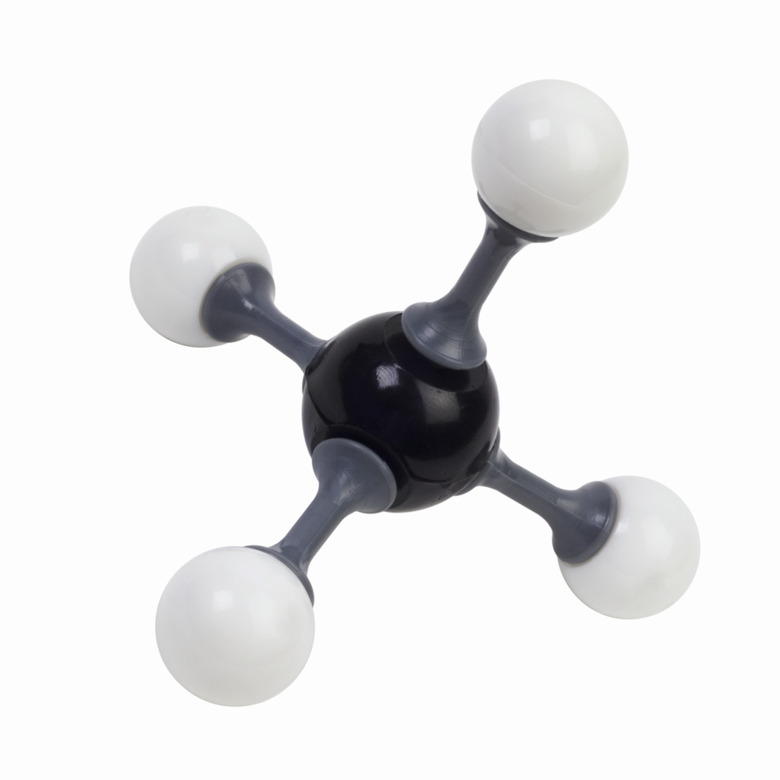What Is The Most Abundant Organic Compound On Earth?
Organic compounds make up the stuff of living things and include molecules that contain the element carbon (C). Most of the carbon in organic compounds is bonded to either hydrogen (H) or oxygen (O). The element nitrogen (N) is also found in abundance in organic compounds, as it contributes significantly to both protein molecules of all kinds and to the two nucleic acids.
The most abundant organic compound on Earth in terms of chemical class is the carbohydrate, one of the four so-called molecules of life along with proteins, lipids and nucleic acids. Cellulose, a storage form of carbohydrate found in plants that humans cannot digest, is among the most plentiful of the carbohydrates worldwide.
General Features of Organic Molecules
General Features of Organic Molecules
Organic molecules tend to be very large molecules, including hundreds to tens of thousand of individual atoms. Because carbon can form four bonds, the "backbones" of these molecules, which may be linear, in a ring or in a combination, are usually made almost entirely of carbon.
The solubility of organic molecules in water varies; the fatty acids of lipids, for example, are famously hydrophobic, or "water-resisting." Some of them contain phosphorus (P) atoms in addition to the elements listed above. About a third of your body consists of organic molecules of some kind.
Nucleic Acids: Bearers of the Genetic Code
Nucleic Acids: Bearers of the Genetic Code
The two nucleic acids in the body, and in nature in general, are **ribonucleic acid (RNA)** and **deoxyribonucleic acid (DNA)**. The sugars forming backbones of these, ribose and deoxyribose, differ by only a single oxygen atom, with RNA having a hydroxyl group (-OH) at a spot in the molecule where DNA has only a hydrogen atom (-H).
DNA is double-stranded, in the form of a helix, and carries the genetic "code" for all proteins made by living things. RNA comes in three main forms, one of which, messenger RNA (mRNA), carries the genetic code for a given protein product from a portion of DNA to the ribosome, where the code is translated into the correct protein product.
Carbohydrate: The Most Abundant Organic Compound in the World
Carbohydrate: The Most Abundant Organic Compound in the World
**Carbohydrates together are the most abundant organic compound on Earth.** Different organic molecules play different biological roles, and within the carbohydrate class, different molecules serve a range of functions, from being the fundamental source of cellular nutrition in all things to providing structural support in the plant world.
All carbohydrates have two H atoms for every O and C atom, giving them the general molecular formula of (CH2O)n. Glucose, for example, is C6H12O6. Simple sugar carbohydrates such as fructose and glucose are known as monosaccharides. Groups of sugar can form polysaccharides; glycogen, for example, is a storage form of carbohydrate in muscle and the liver, made from long chains of glucose molecules.
Lipids: The "Fats" of Life
Lipids: The "Fats" of Life
Lipids are usually the most abundant organic compound in the body, even in lean adults with comparatively little stored fat tissue, making up 15 to 20 percent of the body's mass. They have a lot of carbon and hydrogen but comparatively little oxygen compared to carbohydrates of similar molecular mass.
Triglycerides are the name for dietary fats. These consist of a three-carbon sugar alcohol backbone (glycerol) and three long fatty acids, which may be saturated (i.e., have no double bonds) or unsaturated (i.e., containing one or more double bonds).
Read more about the definition, structure, and function of lipids.
Proteins: Adding Bulk and Variety
Proteins: Adding Bulk and Variety
Proteins are perhaps the most diverse of the macromolecules of life. They are mainly structural, adding solid mass to organs and tissues. Many of them are enzymes, which catalyze (speed up) biochemical reactions in the body many times over.
Proteins are made up of nitrogen-rich amino acids, 20 of which exist in the body. Acting on mRNA's instructions, they are assembled by the two subunits of the ribosome, with the help of a kind of RNA called transfer RNA (tRNA). Each amino acid is added one at a time to the growing chain, which is called a polypeptide and is destined to become a protein when it is released by the ribosome and processed.
Cite This Article
MLA
Beck, Kevin. "What Is The Most Abundant Organic Compound On Earth?" sciencing.com, https://www.sciencing.com/abundant-organic-compound-earth-22851/. 29 July 2019.
APA
Beck, Kevin. (2019, July 29). What Is The Most Abundant Organic Compound On Earth?. sciencing.com. Retrieved from https://www.sciencing.com/abundant-organic-compound-earth-22851/
Chicago
Beck, Kevin. What Is The Most Abundant Organic Compound On Earth? last modified August 30, 2022. https://www.sciencing.com/abundant-organic-compound-earth-22851/
